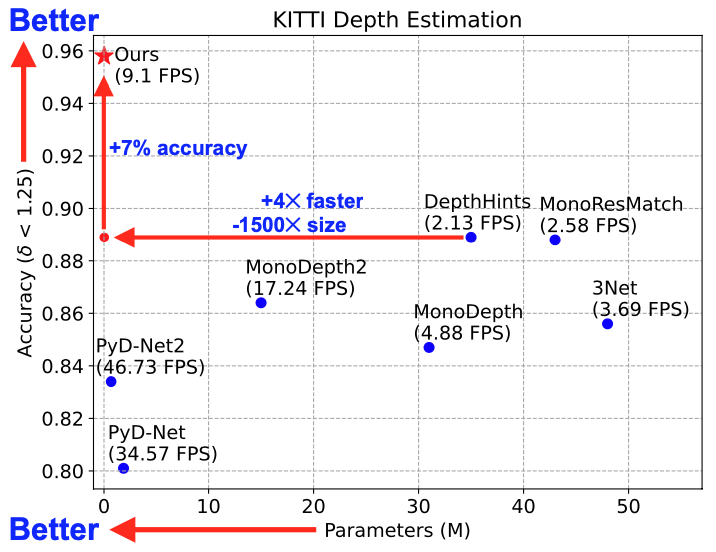This repository is the official source code (with PyTorch) for our CVPR 2023 Workshops (EVW) paper, ES³Net: Accurate and Efficient Edge-based Self-Supervised Stereo Matching Network.
We adapt the efficient cost-volume-based stereo matching network (RealTimeStereo) to self-supervised learning, allowing us to estimate metric depth and to fine-tune the network on embedded devices, such as the drone.
Efficient and accurate depth estimation is crucial for real-world embedded vision applications, such as autonomous driving, 3D reconstruction, and drone navigation. Stereo matching is considered more accurate than monocular depth estimation due to the presence of a reference image, but its computational inefficiency poses a challenge for its deployment on edge devices. Moreover, it is difficult to acquire ground-truth depths for supervised training of stereo matching networks. To address these challenges, we propose Edge-based Self-Supervised Stereo matching Network (ES³Net), which efficiently estimates accurate depths without ground-truth depths for training. We introduce dual disparity to transform an efficient supervised stereo matching network into a self-supervised learning framework. Comprehensive experimental results demonstrate that ES³Net has comparable accuracy with stereo methods while outperforming monocular methods in inference time, approaching state-of-the-art performance. The efficient and reliable estimation of depths on edge devices using ES³Net lays a good foundation for safe drone navigation.
We provide a YAML file for building the environment with conda.
conda env create -f environment.yml
You can also manually build up the environment by installing dependency in the environment.yml.
We use the same data loaders of PSMNet and RealTimeStereo. Please modify the dataset as these works.
python train.py --data_path <dataset path> --dataset <dataset name>
If you want to use your own dataset, please use self as the dataset name
python test.py --load_cpt_path <model checkpoint path> \
--imgL_path <left image path> --imgR_path <right image path> \
--save_path <path for saving disparity map>
If you want to test multiple pairs, you need to create two directories, "RGB_left" and "RGB_right", under the main directory.
python test.py --load_cpt_path <model checkpoint path> \
--data_path <dataset path> --save_path <path for saving disparity map>
We provide the model checkpoint pre-trained on KITTI Raw in this repository.
The filename of checkpoint is ES3Net_kitti_raw_best.cpt.
@InProceedings{Fang2023ES3Net,
author = {Fang, I-Sheng and Wen, Hsiao-Chieh and Hsu, Chia-Lun and Jen, Po-Chung and Chen, Ping-Yang and Chen, Yong-Sheng},
title = {ES3Net: Accurate and Efficient Edge-Based Self-Supervised Stereo Matching Network},
booktitle = {Proceedings of the IEEE/CVF Conference on Computer Vision and Pattern Recognition (CVPR) Workshops},
year = {2023},
}This code is based on PSMNet, RealTimeStereo and monodepth

